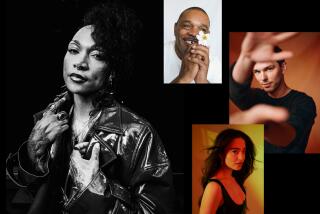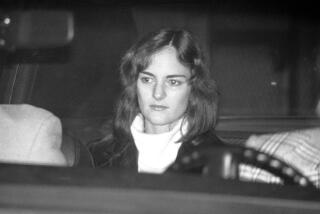Los Angeles as Seen Through the Lens of a Bygone Era
- Share via
Others may have offered a more romanticized view of a growing Los Angeles--the palm-framed sunset, those glittery movie star parties, the Art Deco glamour of Wilshire Boulevard.
But for three decades, one group of photographers preferred to aim their lenses in another direction.
They were Hearst newspaper cameramen in the 1930s, ‘40s and ‘50s, and they prowled the town looking for the lurid and the loony.
What they didn’t find they sometimes invented--re-creating crime scenes, retouching photos to add tears to victims’ faces, even restaging game-winning sports plays.
The newspaper business was high-charged and highly competitive. The city’s six dailies cranked out fresh editions all day long. And the Herald-Express, with screaming headlines and eye-catching photographs, was the loudest of them all.
That tabloid approach to local journalism faded when Hearst merged the splashy Herald-Express with the Examiner in the early 1960s. The somewhat tamer Herald Examiner folded in 1989.
The photographers’ pictures have survived, however.
The Hearst Corp. has donated the newspapers’ 2.2 million-picture file to the Los Angeles Public Library. And a sampling of the huge collection will be publicly unveiled Saturday with an unusual exhibition organized by an unlikely curator: actress Diane Keaton.
On the same day, library leaders are sponsoring a public discussion on why Los Angeles news coverage between 1930 and 1960 was so compelling--even if it was a little contrived.
Several former Hearst photographers will join other journalists and historians to explain how Los Angeles newspapers used to tailor their coverage to appeal to specific readers. And to explain why news photos back then were often posed and airbrushed to help do just that--tactics that current day newspapers generally avoid.
The 2 p.m. seminar at the downtown Central Library’s Taper Auditorium is open to the public and free.
Scores of the old newspaper photos will be on display in two sections, at the library’s second-floor Getty Gallery and its smaller first-floor galleries.
The larger exhibit, titled “Local News,” was organized by Keaton and will be on view through Dec. 18. The companion display, called “Extra! More Local News,” will be open through Jan. 16.
Keaton selected the photographs in her exhibit after spending two years rummaging through the 4,000 boxes of Hearst news photos shelved in a library basement storeroom.
A photo hobbyist who has edited two photographic books and published a third with her own pictures, Keaton plans to include the Herald-Express photos in a new book.
Keaton became involved with the old news photo collection by accident.
She was browsing at a 1994 flea market at Pasadena City College when she bumped into Carolyn Kozo Cole, who heads the library’s photo collection. Aware of the actress’ interest in photography, Cole invited her to look at the Hearst pictures.
Keaton quickly said yes. Her grandmother had been a loyal Herald-Express reader, she said. “She loved it. She even had it delivered. She lived to rehash the Herald’s coverage of local horror stories,” Keaton said.
In Keaton’s view, the Herald-Express satisfied its blue-collar readers by serving up a daily litany of the misfortunes of people just like them. At the same time it offered wife-beaters, accident victims and divorcees “a sort of redemption through a pathetically short-lived fame.”
These “are not Cartier-Bresson moments. In all these photographs a kind of deal is made between the person being photographed and the photographer,” Keaton said Thursday.
That’s why the exhibition is filled with such images as a sad-faced 5-year-old Compton boy who is pointing in 1952 to the storm drain where his 3 1/2-year-old playmate drowned. And with the 1947 photo of a restaurant cashier demonstrating how a robber grabbed her by the throat and escaped with $853. And the 1942 picture of children in mock military uniforms playing in their make-believe bomb shelter.
Herald-Express photographers enjoyed a cozy relationship with police. They were welcome at murder scenes and in courtrooms, where they were free to photograph evidence, suspects and bodies. Authorities--and victims--often cooperated in reenacting crimes and moments of mayhem for the camera.
The newspaper routinely retouched photos, lightening backgrounds so that the pictures would reproduce more clearly on Hearst’s smeary presses. (The tactics were common in that era among newspapers, including The Times.)
Sometimes the Herald-Express painted out unwanted figures. Other times it painted-in tears on faces whose real tears weren’t quite visual enough.
Librarian Glen Creason, who has helped transfer the black-and-white prints from their brittle newspaper folders to archive-quality boxes, said the newspaper’s jumbled filing system makes finding specific photos a challenge. But a search of the huge collection is worth it.
Creason said: “It holds the record of every silly, dumb, courageous, misguided, joyful, crazy, noble and knuckle-headed thing the people of this city did” back then.
More to Read
Sign up for Essential California
The most important California stories and recommendations in your inbox every morning.
You may occasionally receive promotional content from the Los Angeles Times.











